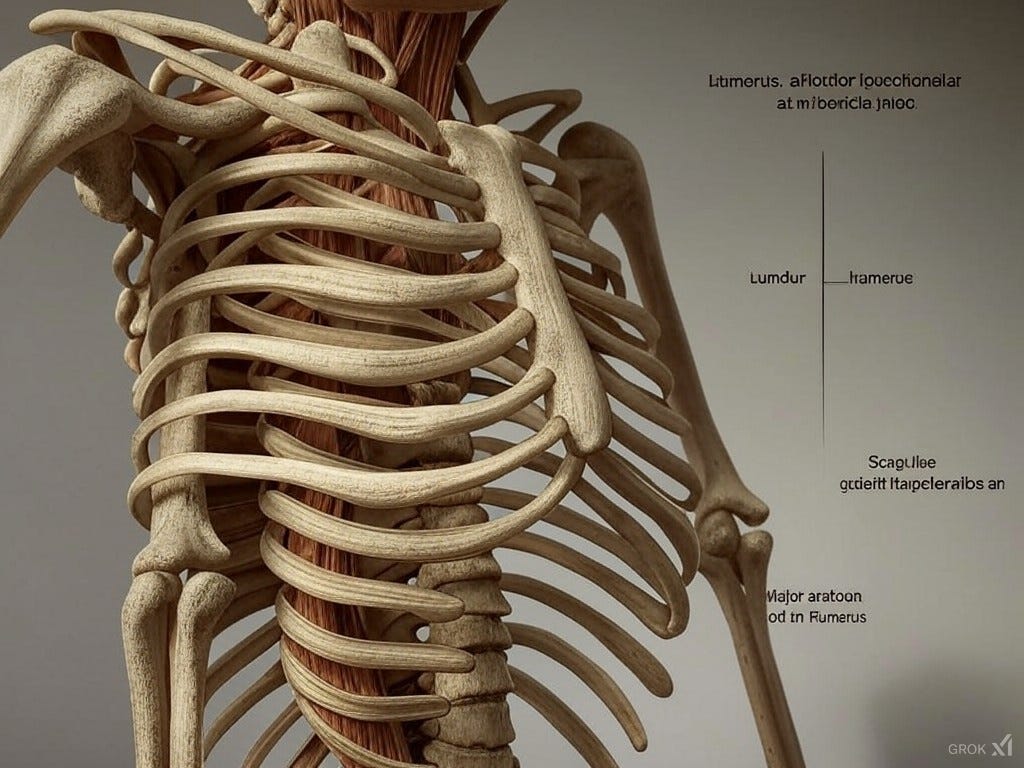Well it looks like me and Grok are getting a little bit more familiar with these lessons, although I think my questions glitched the system. It keeps telling me it can’t create images and yet what it’s produced the last few days has been pretty good. It’s been resisting me pushing it further with more detailed questions.

This lesson is a tough one, do only what you feel comfortable with and take pauses whenever you need. It’s more of what we’ve been doing the last two evenings.
There are many benefits from this lesson if you do persist, or return to it at a later date - remembering that every BODY is different, I like to use these ones as a measuring stick for how much more flexible my spine is becoming.
Spinal Mobility and Strength:
Arch and Lordosis Creation: By encouraging movements that create a lordosis (an inward curve of the spine), the exercises work on increasing the flexibility of the spine. This helps in improving the range of motion, reducing stiffness, and potentially alleviating back pain by promoting even weight distribution across the vertebrae.
Spinal Extension and Flexion: Movements like lifting the shoulders and waist from the floor while maintaining an arch or going back down to the floor with control enhance the muscles' ability to support the spine, particularly the erector spinae, which runs along the spine.
Pelvic Stability:
Pelvic Tilting: The actions described, like protruding the stomach while arching the back, involve tilting the pelvis. This engages the pelvic floor muscles and those around the hips, enhancing stability and control over hip movements.
Shoulder and Arm Coordination:
Shoulder Elevation and Movement: The repeated use of arms in different positions (overhead, forward, or backward) while maintaining back posture helps in strengthening the shoulder muscles and improving coordination between arm movements and torso stability. This can lead to better posture and reduced shoulder strain in daily activities.
Lower Limb Coordination and Strength:
Leg Lifting and Swinging: Exercises where legs are lifted or swung while maintaining certain back positions challenge the lower body's muscle groups, including the hamstrings, quadriceps, and hip flexors. This not only strengthens these muscles but also improves the coordination between the lower limbs and the torso, crucial for balance and mobility.
Sensory-Motor Integration:
Focus on Symmetry and Asymmetry: By exploring movements both symmetrically and asymmetrically (e.g., one arm longer than the other), the lesson helps in fine-tuning one's proprioception — the sense of self-movement and body position. This can correct imbalances, enhance motor control, and increase body awareness.
Breathing and Body Awareness:
Breathing Coordination: Although not explicitly mentioned, these movements implicitly involve breath control, especially when maintaining an arch or lordosis. Proper breathing can enhance the effectiveness of each movement, aiding in muscle relaxation and oxygenation.
Functional Movement Patterns:
Transitioning from Lying to Sitting: The various methods of moving from a supine to a seated position mimic functional movements done in daily life or sports. This not only builds strength in a practical, applicable manner but also teaches efficient ways to use the body's mechanics during these transitions, reducing the risk of injury.
This lesson, through its varied exercises, essentially trains the body to work as an integrated unit, enhancing overall movement quality, stability, and resilience against the stresses of daily activities or more specific physical demands.
Here is the lesson, enjoy learning more about your Self with this curly one:
Keep reading with a 7-day free trial
Subscribe to MySelf.Study to keep reading this post and get 7 days of free access to the full post archives.

